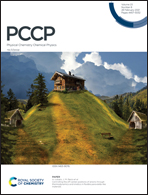Strain-controlled electronic and magnetic properties of tVS2/hVS2 van der Waals heterostructures†
Abstract
The structural, electronic and magnetic properties of the T-phase and H-phase of the VS2 monolayer and their heterobilayers are studied by means of first-principles calculations. We find that the two phases of the VS2 monolayer are both ferromagnetic (FM) semiconductors and that these two monolayers form a typical van der Waals (vdW) heterostructure with a weak interlayer interaction. By comparing the energy of different magnetic configurations, the FM state of the tVS2/hVS2 heterostructure is found to be in the ground state under normal conditions or biaxial strains. Under compressive strains, the anti-FM (AFM) and FM states degenerate. Based on the band structure obtained and the work function, it is found that the T-phase and H-phase are capable of forming an efficient p–n heterostructure. Due to spontaneous charge transfer at the interface, a gapless semiconductor is formed in our HSE06 calculations. We also find that the twist angle between the monolayers has a negligible impact on the band structure of the heterostructure in its spin-down channel. Moreover, the tVS2/hVS2 heterostructure is found to switch from a gapless semiconductor to a metal or a half-metal under some given biaxial or uniaxial strains. Therefore, the heterostructure could be a half-metallic property with strains, realizing 100% polarization at the Fermi level. Our study provides the possibility of realizing 100% spin-polarization at the Fermi level in these FM vdW heterostructures, which is significant for further spin transport exploration.



 Please wait while we load your content...
Please wait while we load your content...